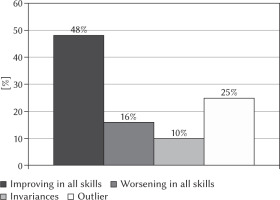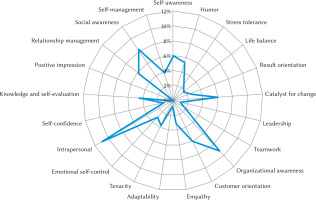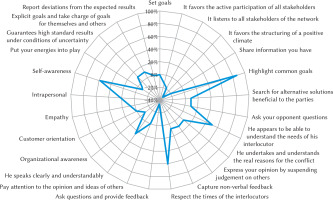BACKGROUND
Fifty-six top managers from 9 southern Italy local health units were mapped on their behavioral approach with the Org-EIQ test (Giorgi & Mancuso, 2014) and Ipacs test (Cioffi et al., 2019) before and after an experiential pathway with mentoring and participative art, integrated with coaching.
The concept of emotional intelligence (EI) is related to the ability to recognize, understand, and use emotional information about oneself, others, as well as organizational and social dynamics that lead to or cause effective or superior performance (Culver, 1998).
Taking into account the recent literature results (Cioffi et al., 2019; Cioffi & Cerbo, 2022; Culver, 1998; Spencer et al., 1994) on the impact of EI on tenacity, optimism, social awareness, as prerequisites to facilitate other core skills achievement, the soft skill “emotional intelligence” has been added to a set of “core competences” composed of 4 soft skills: communication, result orientation, teamwork, networking.
In previous research (Cioffi et al., 2021; Cioffi & Cerbo, 2022) it was observed that the most popular Ipacs behavior indicator related to EI (with the highest percentage of improvement) was “intrapersonal”, which is the ability to observe oneself, to observe the impact of behaviors on the surrounding environment. This ability made it possible to achieve more than 90% of activities in 6 months, in comparison with previous studies, where improvement in other core skills allowed the achievement of approximately 65% of planned activities related to the system outcomes, in 8 months (Cioffi & Cerbo, 2022). These results suggested the role of EI as “meta skill” improving the development of other skills or competences.
The new core competence set and behaviors’ indicators were assessed before and after the Ipacs integrated pathway. Each soft skill, activity and behavior were connected through predefined basic activities with the following three of the National Recovery Plan (NRP) objectives: 1) enrolling new roles for the future health community house (defined in the NRP); 2) defining a systemic communication in oncology; 3) introducing an interoperability application for taking charge of chronicity.
This research is aimed at determining the importance of emotional intelligence behaviors among a set of soft skills selected to facilitate the implementation of NRP goals found by both tests (Giunti and Ipacs). A secondary goal of this research is to understand the percentage of professionals improved in all soft skills.
In this study the following four behavior clusters have been assessed before and after the integrated pathway as synthesis of the 5 skills’ expression: 1) self-awareness that concerns knowing one’s internal states, preferences, resources, intuitions, consisting of recognizing one’s emotions and their effects; 2) self-management that refers to managing one’s internal states, impulses, resources, consisting of emotional self-control, adaptability, achievement orientation, positive outlook; 3) social awareness that refers to how people handle relationship and awareness of others’ feelings, needs, and concerns, consisting of empathy, sensing others’ feeling and perspectives and demonstrating an active interest in their concerns; 4) relationship management that concerns the skill or adeptness at inducing desirable responses in others, sensing others’ development needs and bolstering their abilities. Results are presented for each NRP goal.
In addition, we observed that the Ipacs test and Giunti test (Org-EIQ) indicated the same dimensions and behavior indicators among those of emotional intelligence as a result of an integrated coaching pathway.
PARTICIPANTS AND PROCEDURE
This search was performed using a combination of the following 5 steps:
STEP 1 – INITIAL ASSESSMENT: SOFT SKILLS AND ACTIVITIES
A list of activities essential to achieve NRP goals (called activities IN) was agreed between managers and the coach (Table 1). The activities were related by professionals and the coach to each specific systemic objective as summarized in Table 2. Finally, managers and the coach identified links between activities related to NRP objectives and behaviors as summarized in Table 3.
Activities IN were registered in the Ipacs proprietary platform as activities to be measured along with the behaviors – agreed to facilitate NRP goals. An Ipacs’ observational “test IN” measured – at the beginning of the integrated pathway – the level of 5 skills’ expressions: communication, result orientation, teamwork, networking, emotional intelligence of each of the 56 professionals. The Ipacs questionnaire was composed of 38 questions (12 open and 26 closed) that described a stimulus situation. Each participant was free to state how he would have acted if he had been in the place of the protagonist.
In addition to the Ipacs test, a Giunti test on EI (Org-EIQ), focused specifically on emotional intelligence (Giorgi & Mancuso, 2014), was administered. The Org-EIQ test is composed of 22 questions easy to answer in a short period of time.
Table 1
List of activities agreed to be implemented to facilitate NRP goals
Table 2
Activities IN versus NRP’s goals to be achieved
Table 3
Activities related to behaviors
STEP 2 – PARTICIPATIVE ART AND MENTORING
All managers received a stimulus on using Contemporary Art, video, an artistic video installation program, useful for their final project work as well as to obtain and transfer experiences and stimulate discussion, which the use of social media (video pills, etc.) and photos accelerated. Contemporary Art was placed at the service of managers with the aim of raising awareness of the territories (as new places of care) promoting increasing sense of community and relationship management. It is a new way of thinking, which today the contemporary world seems to approach because of the great adherence to reality.
STEP 3 – TEAM COACHING AND INDIVIDUAL COACHING
Each professional received six hours (5 sessions) of individual coaching sessions as well as 4 sessions of team coaching lasting 3 hours each. A final session was aimed at enhancing all learning achieved during the Ipacs pathway (intuition, awareness, change of state, etc.).
STEP 4 – FINAL ASSESSMENT: SOFT SKILLS AND ACTIVITIES OUT
The Ipacs observational “test OUT” aimed at assessing the level of different skills’ expression at the end of the integrated path was administered to all 56 managers. At the end of individual coaching each manager listed in the empowerment Ipacs platform the implemented activities carried out thank to the integrated coaching program (Activities OUT). The activities OUT list is summarized in Table 4. The results were registered; at the same moment each manager completed the test and sent it to the Ipacs IT platform and Giunti IT platform.
Table 4
Activities OUT list
RESULTS
The comparison between test OUT/test IN showed (Figure 1) that 75% of 56 top managers were enhanced in all the 5 soft skills; 48% of 56 top managers improved all 5 core soft skills, incrementing in, at least, one of the two IE tests (Org-EIQ and Ipacs). 25% of managers were enhanced by over 100% in all the skills.
Figure 1
Percentage of managers who improved in all 5 soft skills after the integrated coaching program

As reported in previous Ipacs research (Cioffi et al., 2019) similar interdisciplinary groups submitted to the same integrated approach improved in all “core” soft skills (results orientation, communication, negotiation, teamwork) only by 20%, on average. This average difference seems therefore to confirm that the EI skill empowers other skills selected as “core” and can be considered as a “meta-skill”.
This research goes into more details of behaviors improved in each system objective, as a deepening step. Figures 2, 3, and 4 summarize behavior indicators, related to each system objective, that improved the most. All figures pointed out as the most relevant to achieve the 3 system objectives the behavior indicator “intrapersonal”. In other words, the 56 managers thanks to their learning to introspect about themselves and reflect on other people in their environment, increased their organizational and social ability, useful to facilitate a new communication in oncology based on global data, a new mindset into the Community House, a new approach to management of chronicity. Intrapersonal behavior increased by 11% on average in all 56 managers.
DISCUSSION
Integrated training with coaching, participative art and mentoring teaches professionals a new mindset: “how to think” instead of “what to think”, pointing out how important it is to hook up with high emotions, instead of stressful emotions, how important it is in daily life to change a set of behaviors and improve correlated “meta-skills” to implement and facilitate achievement of system objectives, in this study related to the NRP. Meta skills such as introspection, critical analysis, imagination and creation, improve the ability to learn continuously.
Principal behaviors pointed out by this research are the following: self-introspection, communicating and sharing common goals, being focused on high standard results, even in conditions of uncertainty, focusing on non-verbal feedback and giving feedback. All those specific emotional intelligence behaviors are triggered by introspecting about oneself and reflecting on others.
The Ipacs test and Giunti test pointed out that both tests returned the same results in behaviors changed, such as introspection, highlighting what is really necessary to coach to achieve specific system objectives in a certain context.
The challenge of future research will be to compare an experimental group following the coaching and participative art program with a control group doing nothing to achieve the same objectives. The measure of indicators will allow us to better understand how art and coaching foster behaviors that help people to accelerate self-awareness, self-management, and social awareness.
Another field of social research is to go into more details on coach competences and impact on accelerating “excellent” results, as well as context and people from different cultures, ethnicities, who undergo an integrated coaching pathway, how art (Martorelli, 2022) facilitates results in a shorter period. Do emotional intelligence behavior indicators act in the same way in all types of culture, ethnicity, and sex (Jorfi et al., 2012)? How do emotional intelligence behavior indicators encourage an innovative approach and opportunities (Biggeri & Ielasi, 2023)? How do resonant leaders develop through emotional intelligence, vision, and coaching (Boyatzis & Smith, 2013)? How does the relationship between the coach and the coaching partner depend on the coach’s emotional intelligence competences (Peña-Sarrionandia et al., 2015)?





